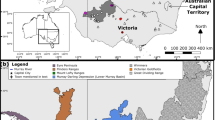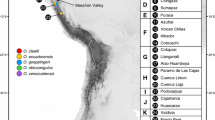Abstract
Molecular markers are routinely used to assess levels of diversity within and among populations, particularly with regard to species of conservation concern. However, when interpreting the level and partitioning of diversity observed, an implicit assumption is often made that the populations of the species in question form a monophyletic group. We tested this assumption in three endemics of Antirrhinum (A. charidemi, A. subbaeticum, and A. valentinum) using 79 nuclear [internal transcribed spacer (ITS)] and 85 plastid (psbA-trnH, trnT-trnL, trnK-matK, trnS-trnG) sequences representing multiple accessions of each of 24 Antirrhinum species (single accession of A. cirrhigerum). These species share six life history traits implicated in levels of genetic diversity, and have been the subject of previous population genetic studies. Populations of all three species formed monophyletic groups on ITS analysis. In contrast, none of the three species formed monophyletic groups on plastid sequence analysis: populations of A. charidemi fall in a monophyletic group including one accession of A. mollissimum, populations of A. subbaeticum form a polyphyletic group with plastid sequences shared with A. pulverulentum, and populations of A. valentinum are unresolved within a clade containing six other species. Lack of monophyly using plastid sequences is interpreted as a combination of shared ancestral polymorphism and hybridization in a reticulate evolutionary history of these species. Monophyly in the ITS tree may reflect a more recent sequence homogenization. We draw attention to the evaluation of species monophyly alongside the contribution of other life history traits in the historical interpretation of the level and partitioning of genetic diversity, and its use in recommendations for species conservation programs.



Similar content being viewed by others
References
Akaike H (1979) A new look at the statistical model identification. IEEE Trans Automat Contr AC-19:716–723
Álvarez I, Cronn R, Wendel JF (2005) Phylogeny of the New World diploid cottons (Gossypium L., Malvaceae) based on sequences of three low copy nuclear genes. Plant Sys Evol 252:199–214
Arnold ML (1997) Natural hybridization and evolution. Oxford University Press, New York
Baur E (1932) Artumgrenzung und Artbildung in der Gattung Antirrhinum, Sektion Antirrhinastrum. Z Indukt Abstamm Vererbungsl 63:256–302
Boscaiu M, Riera J, Estrellés E, Güemes J (1997) Números cromosomáticos de plantas occidentales, 751–776. An Jard Bot Madr 55:430–431
Carrió E, Jiménez JF, Sánchez-Gómez P, Güemes J (2009) Reproductive biology and conservation implications of three snapdragon species (Antirrhinum, Plantaginaceae). Biol Conserv 142:1854–1863
Chase MW, Knapp S, Cox AV, Clarkson JJ, Butsko Y, Joseph J, Savolainen V, Parokonny AS (2003) Molecular systematics, GISH and the origin of hybrid taxa in Nicotiana (Solanaceae). Ann Bot (Lond) 92:107–127
Coy E, Tamayo MJ, Carrillo AF, Sánchez-Gómez P, Güemes J (1997) Números cromosomáticos de plantas occidentales, 746–750. An Jard Bot Madr 55:430
Degnan JH, Rosenberg NA (2009) Gene tree discordance, phylogenetic inference and the multispecies coalescent. Trends Ecol Evol 24:332–340
Diosdado JC, Vioque J, Juan R, Pastor J (1994) IOPB chromosome data 7. Int Org Pl Biosyst Newslett 22:3–4
Doyle JJ (1992) Gene trees and species trees—molecular systematics as one—character taxonomy. Syst Bot 17:144–163
Fatemi M, Gross CL (2009) Life on the edge—high levels of genetic diversity in a cliff population of Bertya ingramii are attributed to B. rosmarinifolia (Euphorbiaceae). Biol Conserv 142:1461–1468
Fazekas AJ, Burgess KS, Kesanakurti PR, Graham SW, Newmaster SG, Husband BC, Percy DM, Hajibabaei M, Barrett SCH (2008) Multiple multilocus DNA barcodes from the plastid genome discriminate plant species equally well. PLoS One 3(7):e2802
Fuertes Aguilar J, Rosselló JA, Nieto Feliner G (1999) Nuclear ribosomal DNA (nrDNA) concerted evolution in natural and artificial hybrids of Armeria. Mol Ecol 8:1341–1346
Funk DJ, Omland KE (2003) Species-level paraphyly and polyphyly: frequency, causes, and consequences, with insights from animal mitochondrial DNA. Annu Rev Ecol Syst 34:397–423
Garnett ST, Christidis L (2007) Implications of changing species definitions for conservation purposes. Bird Conserv Int 17:187–195
Gitzendanner MA, Soltis PS (2000) Patterns of genetic variation in rare and widespread plant congeners. Am J Bot 87:783–792
Goodwillie C, Stiller JW (2001) Evidence for polyphyly in a species of Linanthus (Polemoniaceae): convergent evolution in self-fertilizing taxa. Syst Bot 26:273–282
Güemes J (2009) Antirrhinum L. In: Castroviejo S, Herrero A, Benedí C, Rico E, Güemes J (eds) Flora Iberica.13. CSIC, Madrid, pp 134–166
Hall TA (1999) BioEdit: a user-friendly biological sequence alignment editor and analysis program for Windows 95/98/NT. Nucleic Acids Symp Ser 41:95–98
Hamilton M (1999) Four primers pairs for the amplification of chloroplast intergenic regions with intraspecific variation. Mol Ecol 8:521–523
Hamrick JL, Godt MJW (1989) Allozymic diversity in plant species. In: Brown AHD, Clegg MT, Kahler AL, Weir BS (eds) Plant population genetics, breeding and germplasm resources. Sinauer, Sunderland, pp 43–63
Hamrick JL, Godt MJW (1996) Effects of life history traits on genetic diversity in plant species. Philos Trans R Soc Lond B Biol Sci 351:1291–1298
Hamrick JL, Linhart YB, Mitton JB (1979) Relationships between life history characteristics and electrophoretically detectable genetic variation in plants. Annu Rev Ecol Syst 10:173–200
Hamrick JL, Godt MJW, Sherman-Boyles SL (1992) Factors influencing levels of genetic diversity in woody plant species. New Forests 6:95–124
Hardig TM, Soltis PS, Soltis DE (2000) Diversification of the North America shrub genus Ceanothus (Rhamnaceae): conflicting phylogenies from nuclear DNA and chloroplast DNA. Am J Bot 87:108–123
Harrison BJ, Darby LA (1955) Unilateral hybridization. Nature 176:982
Hughes CE, Eastwood RJ, Bailey CD (2006) From famine to feast? Selecting nuclear DNA sequence loci for plant species-level phylogeny reconstruction. Philos Trans R Soc Lond B Biol Sci 361:211–225
Isaac NJB, Mallet J, Mace GM (2004) Taxonomic inflation: its influence on macroecology and conservation. Trends Ecol Evol 19:464–469
Jiménez JF, Sánchez-Gómez P, Güemes J, Werner O, Rosselló JA (2002) Genetic variability in a narrow endemic snapdragon (Antirrhinum subbaeticum, Scrophulariaceae) using RAPD markers. Heredity 89:387–393
Jiménez JF, Sánchez-Gómez P, Güemes J, Rosselló JA (2005) Phylogeny of snapdragon species (Antirrhinum; Scrophulariaceae) using non-coding cpDNA sequences. Isr J Plant Sci 53:47–54
Kelchner SA (2000) The evolution of non-coding chloroplast DNA and its application in plant systematics. Ann Mo Bot Gard 87:482–498
Linder CR, Rieseberg LH (2004) Reconstructing patterns of reticulate evolution in plants. Am J Bot 91:1700–1708
Loveless MD, Hamrick JL (1984) Ecological determinats of genetic tructure in plant populations. Annu Rev Ecol Syst 15:65–95
Mace GM (2004) The role of taxonomy in species conservation. Philos Trans R Soc Lond B Biol Sci 359:711–719
Maddison W, Knowles L (2006) Inferring phylogenetic despite incomplete lineage sorting. Syst Biol 55:21–30
Mateu-Andrés I (1999) Allozymic variation and divergence in three species of Antirrhinum L. (Scrophulariaceae–Antirrhineae). Bot J Linn Soc 131:187–199
Mateu-Andrés I (2004) Low levels of allozyme variability in the threatened species Antirrhinum subbaeticum and A. pertegasii (Scrophulariaceae): implications for conservation of the species. Ann Bot (Lond) 94:797–804
Mateu-Andrés I, de Paco L (2006) Genetic diversity and the reproductive system in related species of Antirrhinum. Ann Bot (Lond) 98:1053–1060
Mateu-Andrés I, Segarra-Moragues JG (2000) Population subdivision and genetic diversity in two narrow endemics of Antirrhinum L. Mol Ecol 9:2081–2087
Mateu-Andrés I, Segarra-Moragues JG (2003) Patterns of genetic diversity in related taxa of Antirrhinum L. assessed using allozymes. Biol J Linn Soc 79:299–307
Mayden R (1997) A hierarchy of species concepts: the denouement in the saga of the species problem. In: Claridge M, Dawah H, Wilson M (eds) Species: the units of biodiversity. Chapman and Hall, London, pp 381–424
Moreno JC (2008) Lista roja 2008 de la flora vascular española. Dirección General de Medio Natural y Política Forestal (Ministerio de Medio Ambiente, y Medio Rural y Marino, y Sociedad Española de Biología de la Conservación de Plantas), Madrid
Nybom H (2004) Comparison of different nuclear DNA markers for estimating intraspecific genetic diversity in plants. Mol Ecol 13:1143–1155
Nylander JAA (2004) MrModeltest 2.1. Program distributed by the author. Evolutionary Biology Centre, Uppsala University
Posada D, Crandall KA (1998) Modeltest: testing the model of DNA substitution. Bioinformatics 14:817–818
Rieseberg LH (1997) Hybrid origins of plant species. Annu Rev Ecol Syst 28:359–389
Rieseberg LH, Wendel J (1993) Introgression and its consequences in plants. In: Harrison R (ed) Hybrid zones and the evolutionary process. Oxford University Press, New York, pp 70–114
Ronquist F, Huelsenbeck JP (2003) MrBayes 3: Bayesian phylogenetic inference under mixed models. Bioinformatics 19:1572–1574
Rosenberg NA (2002) The probability of topological concordance of genes tress and species trees. Theor Popul Biol 61:225–247
Rothmaler W (1956) Taxonomische Monographie der Gattung Antirrhinum. Feddes Repert 136:1–24
Salamin N, Chase MW, Hodkinson TR, Savolainen V (2003) Assesing internal support with large phylogenetic DNA matrices. Mol Phylogenet Evol 27:528–539
Sánchez-Gómez P, Jiménez JF, Carrión MA, Güemes J (2003) Antirrhinum subbaeticum Güemes, Mateu and Sánchez-Gómez. In: Bañares A, Blanca G, Güemes J, Moreno JC, Ortiz S (eds) Atlas y libro rojo de la flora vascular amenazada de España. Dirección General de Conservación de la Naturaleza, Madrid, pp 588–589
Savolainen V, Chase MW (2003) A decade of progress in plant molecular phylogenetics. Trends Genet 19:717–724
Squirrell J, Gornall RJ, French GC, Pullan M, Hollingsworth PM (2006) Genetical Flora of the British Isles database. http://rbg-web2.rbge.org.uk/geneticflora. Accessed 01 Sept 2009
Sutton DA (1988) A revision of the tribe Antirrhineae. Oxford University Press, London
Swofford DL (2002) PAUP*: phylogenetic analysis using parsimony and other methods, version 4.0b. Sinauer, Sunderland
Syring J, Farrell K, Businský R, Cronn R, Liston A (2007) Widespread genealogical nonmonophyly in species of Pinus Subgenus Strobus. Syst Biol 56:163–181
Taberlet P, Gielly L, Pautou G, Bouvet J (1991) Universal primers for amplification of three non-coding regions of chroloplast DNA. Plant Mol Biol 17:1105–1109
Torres E, Iriondo JM, Pérez C (2002) Vulnerability and determinants of reproductive success in the narrow endemic Antirrhinum microphyllum (Scrophulariaceae). Am J Bot 89:1171–1179
Torres E, Iriondo JM, Pérez C (2003) Genetic structure of an endangered plant, Antirrhinum microphyllum (Scrophulariaceae): allozyme and RAPD analysis. Am J Bot 90:85–92
Treutlein J, Smith GF, van Wyk B-E, Wink M (2003) Evidence for the polyphyly of Haworthia (Asphodelaceae, subfamily Alooideae; Asparagales) inferred from nucleotide sequences of rbcL, matK, ITS1 and genomic fingerprinting with ISSR-PCR. Plant Biol 5:513–521
Vargas P, Rosselló JA, Oyama R, Güemes J (2004) Molecular evidence for naturalness of genera in the tribe Antirrhineae (Scrophulariaceae) and three independent evolutionary lineages from the New World and the Old. Plant Syst Evol 249:151–172
Vargas P, Carrió E, Guzmán B, Amat E, Güemes J (2009) Antirrhinum (Scrophulariaceae) speciation since the Pliocene based on plastid and nuclear DNA polymorphisms. J Biogeogr 142:1854–1863
Vardas P, Ornosa C, Ortiz-Sánchez FJ, Arroyo J (2010) Is the ocluded corolla of Antirrhinum bee-specialized? J Nat Hist 44:1427–1443
Vieira CP, Charlesworth D (2001) Low diversity and divergence in the fil1 gene family of Antirrhinum (Scrophulariaceae). J Mol Evol 52:171–181
Webb DA (1971) Taxonomic notes on Antirrhinum L. Bot J Linn Soc 64:271–275
Whibley AC, Langlade NB, Andalo C, Hanna AI, Bangham A, Thébaud C, Coen E (2006) Evolutionary paths underlying flower color variation in Antirrhinum. Science 313:963–966
Xue Y, Carpenter R, Dickinson HG, Coen ES (1996) Origin of allelic diversity in Antirrhinum S locus RNases. Plant Cell 8:805–814
Acknowledgments
We are grateful to: F. Amich, G. Bacchetta, S. Bernardos, I. Marques, L. Medina, S. Ortiz, J. Riera, and M. Santos for plant materials; E. Cano for laboratory expertise; and Consejería de Medio Ambiente (Junta de Andalucía) and Conselleria de Medi Ambient, Aigua, Urbanisme i Habitatge (Generalitat Valenciana) for providing us with permissions to collect A. charidemi and A. valentinum plant material, respectively. This research was supported by the Spanish General Direction of Scientific and Technical Research (DGICYT) through project REN2002-02434/GLO.
Author information
Authors and Affiliations
Corresponding author
Rights and permissions
About this article
Cite this article
Carrió, E., Forrest, A.D., Güemes, J. et al. Evaluating species nonmonophyly as a trait affecting genetic diversity: a case study of three endangered species of Antirrhinum L. (Scrophulariaceae). Plant Syst Evol 288, 43–58 (2010). https://doi.org/10.1007/s00606-010-0311-4
Received:
Accepted:
Published:
Issue Date:
DOI: https://doi.org/10.1007/s00606-010-0311-4




